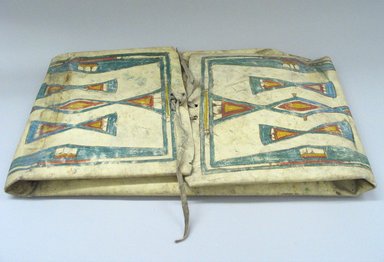
Artist:Arapaho
Medium: Hide, pigment
Geograhical Locations:
Dates:ca. 1900
Dimensions: 26 1/2 x 15 1/2 x 1 1/2 in. (67.3 x 39.4 x 3.8 cm)
Collections:
Exhibitions:
Accession Number: X1111.3
Image: CUR.X1111.3.jpg,
Catalogue Description: Arapaho parfleche bag with painted stripes and diamond-shaped figures in red, green, blue and yellow. Condition is good. Hide somewhat stiff. The Arapaho believed that Whirlwind Woman, a mystical woman, taught them how to make their designs. The six spots around the hide are where Whirlwind Woman sat down when painting the design. The white rectangles or squares are symbolic of where the buffalo came into the world. The bar inside the edges is often seen in Arapaho designs. The black triangular figures are called Wal-say-dad or bear hands whether they do or do not show any claws. Arapaho parfleches often have a large amount of unpainted surface like this one and the use of sky-blue or green is the favorite color choice. The black used in outlining often came from the Cheyenne along the Powder River area. Arapaho women often were specialists in making certain types of things such as this bag. The buffalo hair side is turned inside but with hair removed. The bag would be used for food stuffs, such as dried meats, dried cherries, fat back and peppermint leaves, often stored for long times as emergency rations. It could also be used for other things; clothes, or feathers from headdresses. Former number 67954.1